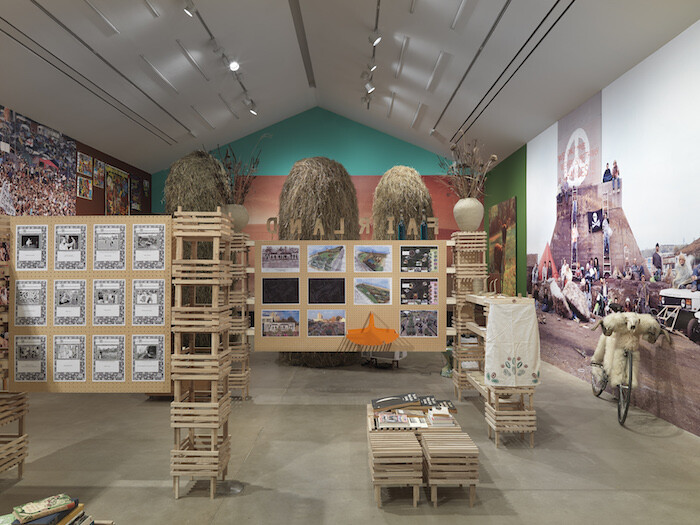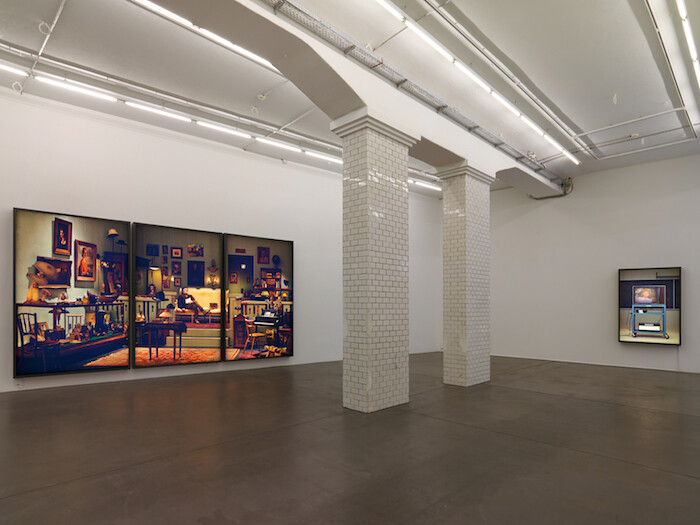Categories
Subjects
Authors
Artists
Venues
Locations
Calendar
Filter
Done
March 15, 2018 – Review
“The Land We Live In – The Land We Left Behind”
Tom Jeffreys

To shit on a book—surely only an animal could do such a thing? In a former farm building, now home to Hauser & Wirth Somerset, lies an early edition of a book by Mark Twain: A Yankee at the Court of King Arthur (1889), a satire of medieval European chivalry told through the eyes of a nineteenth-century Connecticut engineer named Hank. On the left-hand page is an annotated diagram of a tree, its roots taking nourishment from the “soil of common sense.” On the right-hand page, Twain’s text advocates something universally human: “A man is a man, at bottom… even the Russians; plenty of manhood in them—even in the Germans—if one could but force it out.”
Weighting the pages open and obscuring some of the text is a pair of slender turds made from gleaming bronze. It’s unclear exactly what creature might have left them—my guess is a pine marten. They’re from “British Mammal Shits” (2012), Marcus Coates’s series of bronze casts of the droppings of foxes, otters, hedgehogs, and other animals. If Twain is emphasizing a shared humanity against the differences accentuated by the rising nationalism of the late nineteenth century, then Coates—with a sense of absurdity characteristic …
February 3, 2017 – Review
Rodney Graham’s “Media Studies”
Aoife Rosenmeyer

Rodney Graham’s large-format light-box tableaux have been a mainstay of his oeuvre since 2006, and are consistently sophisticated and detailed. The artist’s current exhibition at Hauser & Wirth in Zurich includes seven new light-box works that do not disappoint, but, I wondered, why produce these works now?
Graham has been active as a musician and artist for several decades, playing a key protagonist in his own pieces from the 1990s onwards. His looping film works, such as Photokinetoscope (2001) or Vexation Island (1997) have long been in the contemporary canon. His light-boxes, meanwhile, show chromogenic prints charged with color sandwiched between transparent surfaces, all the better to view images stuffed with detail. The exhibition’s title image, Media Studies ’77 (2016), is a diptych more than two meters tall and nearly four wide showing Graham posing as professor perched on a bent sheet steel desk in front of a blackboard, media trolley at the ready, a cigarette in the hand with which he emphasizes his point while looking right into the middle distance. His russet cords have a slight flare, a suede jacket drapes over his shoulders, and his glasses are tinted. The setting—painted breeze block walls, the clunky television remote, plug …
June 7, 2013 – Review
“Trade Routes”
Omar Kholeif

Hauser & Wirth opened its latest show in its flagship London location at 196 Piccadilly with a new exhibit entitled “Trade Routes.” The exhibition comes at a time when recent iterations of major international exhibitions from the likes of Documenta to the Gwangju Biennale, Istanbul Biennial, and Sharjah Biennial have taken an ever more geographically de-centered approach to forming their artist lists. The notion of the Global South as a curatorial starting point has seen an ever-increasing diversity of artist names on major exhibition calendars, and has given rise to such initiatives as the New Museum’s Museum as Hub, an international network of small and large institutional partners collectively adopting a shared theme for examination. Likewise, the Tate Modern has continued to use its Project Space (formerly known as the Level 2 Gallery) to engage in collaborations with small- to medium-sized international art spaces rarely profiled in hegemonic institutions. Most recently, Lisson Gallery furthered its reach specifically into North Africa with its Cairo-based collaboration, “The Magic of the State” with the project space Beirut, and its recent appointment of Nayrouz Tatanaki (a British-Libyan specialist in Modern Arab, Turkish, and Iranian Art) as an Associate Director.
Looking to the …
March 2, 2012 – Review
Dan Graham’s "Rock ‘n’ Roll Show. Unrealised Projects for Children and Boutique Architecture"
Aoife Rosenmeyer

It’s an imperfect exhibition, neither focusing on one aspect of Dan Graham’s work, nor conveying its breadth: nonetheless, since his MoCA LA retrospective in 2009 (and before that to boot), it has hardly seemed necessary to state his importance in the development of conceptual art, or how his multifaceted practice swoops merrily from high to low registers, embedded in social observation and engagement with his audience. With this in mind, the exhibition’s saving grace is that Graham is not afraid to prick the bubble of his own hype.
The exhibition features three models for glass and aluminium pavilions. They’re each 70 cm tall and presented here almost at (adult) eye level on table-like pedestals. It’s a beguiling game of smoke and mirrors, in which we oversized observers are reflected like giants while taking in Graham’s optical trickery created by a variety of glass and metal treatments. From one side, Sine Curve / Straight Line Two-Way Mirror Pavilion (2011), projects an amorphous curved doubling of its form; when viewed from the other direction, it disappears into itself. But the po-faced reverence with which these structures are received does them no favors, putting them in danger of being seen merely as monumental, formal …
July 12, 2011 – Review
Christoph Büchel’s “Piccadilly Community Centre”
Karen Archey

Something uncanny this way comes at Hauser and Wirth London: for Christoph Büchel’s latest feat in politically-charged trompe l’oeil, the Swiss artist dropped a well-used community center straight onto Piccadilly. Though it only opened a couple weeks ago, the gallery’s usual parquet is covered by worn linoleum, and each successive room is perfectly decorated and organized for dance lessons, art therapy, and other various classes in full swing—the space even smells authentic. Though upon looking further, a curious eye will detect a few uncanny moments pointing to the artist’s critical engagement in creating such a space: a reproduced Rothko hangs in the prayer room, seemingly announcing and deflecting its transcendental nature; and upstairs the Geranium Shop for the Blind is situated next to a outpost for the Conservative Party Archive—a potent juxtaposition beckoning a consideration of Big Society politics.
On a tip from a casually-clad gallery attendant, I stumbled through a door labelled “Private” and into a magnificent, post-apocalyptic pile of trash. “There isn’t even anything I want to steal here,” a visitor to the Piccadilly Community Centre moaned. “Yeah, it’s all a bunch of crap!” added another. Cots with strewn bed sheets, which were more like human-sized rats’ nests, and …